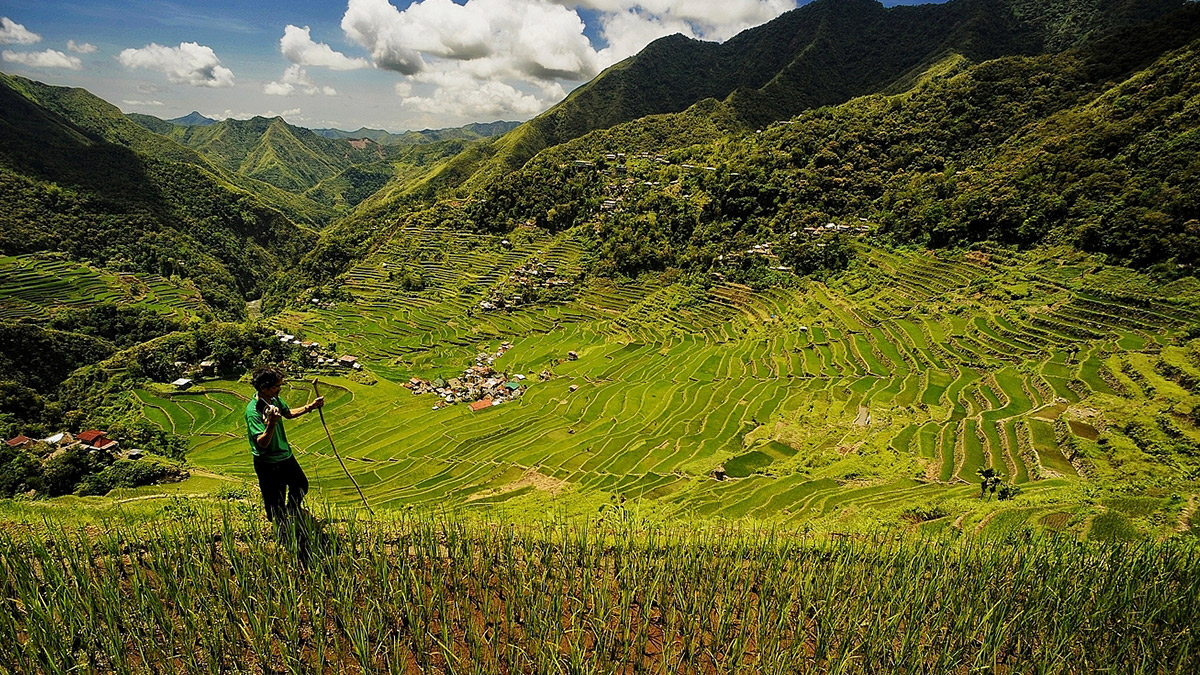
HERITAGE SITE The Batad rice terraces in Banaue, Ifugao, shown in this April 2013 photo, are the most picturesque of the terraces that make up the United Nations Educational, Scientific and Cultural Organization’s World Heritage Site. But a number of terraced farms in Ifugao have been abandoned by their owners and the Department of Agriculture wants to rehabilitate them in the coming years to help improve the country’s rice production. —Ev Espiritu
BAGUIO CITY, Philippines — Abandoned or idle rice terraces in Ifugao province would be brought back to life under a new government strategy to sustain the granaries of the Cordillera, agriculture officials said.
Department of Agriculture (DA) Assistant Secretary for Logistics Daniel Atayde said here last week that the agency would include in future annual national budget allocations the repair of popular centuries-old terraced farms in the Ifugao towns of Banaue, Kiangan, Hungduan and Mayoyao, which have been named as a World Heritage Site by the United Nations Educational, Scientific and Cultural Organization (Unesco).
Mountain Province also boasts rock-walled terraces that grow rice for its communities, including those in the town of Sagada. In other upland Cordillera towns, farmers carved out vegetable gardens by following the natural contour of the mountains.
READ: Save the rice terraces
The new DA allocations would rebuild broken terraces and finance the reactivation of idle terraced farms to improve productivity, added Jennilyn Dawayan, DA Cordillera director.
Dawayan and Atayde joined local chefs who cooked a giant paella, using the Cordillera’s heirloom rice called “tinawon,” at Burnham Park here on May 30 during the closing ceremony for this year’s Farmers and Fisherfolk Month celebrations.
“As policy, the government will make sure full rehabilitation of the terraces means making sure the revived paddies are productive,” Dawayan told the Inquirer.
READ: On the edge: Saving Ifugao rice terraces
The Cordillera terraces are unique for its indigenous water engineering system, which placed the mountain-carved terraces beneath “muyong” (community forest) to conserve rainwater, reduce soil erosion and regulate run-off water flowing down man-made or natural canals to layers of rice paddies (“payao”). The muyong forests also provided timber for woodcarvers.
Dawayan said DA would determine the number and condition of abandoned terraces to determine how much rehabilitation funding should be included in next year’s budget.
Outside the World Heritage Site, smaller rice terraces were converted into vegetable gardens to maintain the family businesses, Banaue Mayor Joel Bungallon had said in March.
Aging farmers
Radiocarbon dating of the terraces by the Ifugao Anthropology Project led by US-based archaeologist Stephen Acabado and uncovered relics placed these man-made wonders as 400 years old.
However, for over two decades, upland communities have struggled with abandoned family-owned terraces because young generations refused to farm or have moved to the cities to learn modern trade skills at the prodding of their own parents, according to archival reports and studies.
The high number of aging farmers and their workers was also among the observations listed by Unesco after it declared the Cordillera terraces a World Heritage Site in 1995. Recent demographic profiles put the average upland farmer in their mid-50s.
This phenomenon was also recorded when the Ifugao terraces were declared as a globally important agricultural heritage system in 2011.
Dawayan said DA researchers learned that many terraced farm owners are open to assistance, mainly from community members who would rebuild their payao and grow “tinawon” in exchange for a share of the harvest.
The government can pursue this strategy by tapping programs of other agencies, like the Department of Labor and Employment, that subsidize workers willing to farm idle terraces for a harvest share, said Dawayan.
Ifugao has a similar community support system, the traditional “chawwa,” where neighbors take over untended payao for a share in production. In 2016, then Banaue mayor and now Ifugao Gov. Jerry Dalipog employed chawwa to revive 341.7 hectares of idle terraces to supply a popular restaurant. —Vincent Cabreza